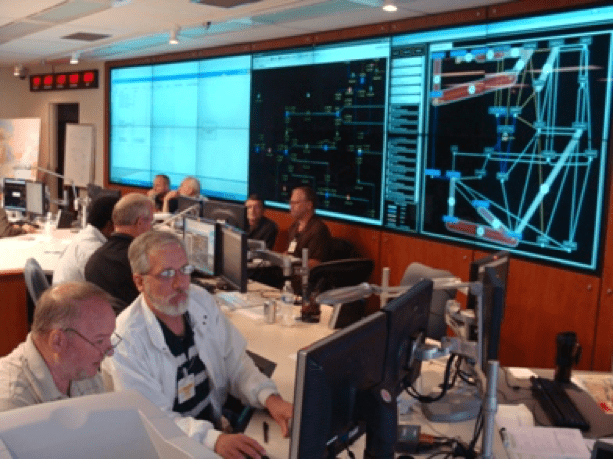The Electricity Infrastructure Operations Center (EIOC) at Pacific Northwest National Laboratory brings together industry-leading software, real-time grid data and advanced computation into a fully capable control room.
PNNL researchers are exploring how changes in the way the nation’s electrical grid is operated can improve its reliability, lower costs and lessen environmental impacts. The focus is on developing real-time tools and supporting their integration into operating systems. They recognize and understand the need for new tools that provide not only a better view of the current power grid, but also faster and more accurate predictions of what might be happening so operators can quickly respond.
Shaped with input from utilities, technology vendors and researchers across the Northwest, the EIOC serves as a unique platform for researching, developing and deploying technologies to better manage and control the grid. The new technologies developed here will be transferable across the industry and address the national need for a more reliable and effective electricity grid.

IncSys & PNNL Partnership Project
IncSys and PNNL have been cooperating on cognitive task analysis as a basis for operator training and operator decision tools since fall of 2008. The initial research has been presented at the NDM 9 conference “Natural Decision Making for Power System Operators’. This paper extended the Dr. Gary Klein model for expert decision making by integrating levels of situation awareness, with the process of building a complete and consistent “story”.
August 4-6, 2009
At EIOC at PNNL in Richland, WA, IncSys and PNNL pioneered one of the first formal human factors studies of operator performance with a control group and an experimental group to evaluate the effectiveness of Graphical Contingency Analysis. Control room operators from several Northwest utilities participated in exercises identifying and preventing the occurrence of cascading blackouts using the 29 station hypothetical PALCO system in Generic PowerSimulator.
June 14-18, 2010
During June 14th to 18th, 2010 the operator performance experiment was taken to a new level at the PNNL EIOC. The conventional tabular contingency analysis and the advanced graphical contingency analysis have been integrated into the WECC Transmission Operations with Voltage Control class, which was delivered by WECC Trainer Robert Eubank. The class was designed to simultaneously meet the goals of objectively evaluating the benefits of an advanced visualization tool and to also meet the goals of providing NERC certified training to power system operators.
These exercises have proven the strategic capability of the EIOC in evaluating cutting edge technologies in collaboration with industry. Such evaluations can be used to justify the integration of new technologies by vendors and subsequent adoption by utilities, as well as justifying R&D expenditures in new technology by DOE.
August 22, 2013
IncSys and PNNL conducted another joint training event as part of PNNL’s Future Power Grid Initiative (FPGI) project. The FPGI project is focused on developing technologies to sustain the reliability and enhance the efficiency of the nation’s electric grid. The Department of Energy understands that the human element is essential to building the next generation of grid management systems. In turn, PNNL is using the FPGI project to focus on Visualization and Decision Support. Through simulation and knowledge capture, PNNL has collaborated with IncSys to conduct a study that captures operator knowledge during a simulation scenario.
By documenting and analyzing the actions and communications of experienced operators in realistic scenarios, PNNL hopes to build research toward new cognitive assistant tools to aid operators and planners in the future as the North American power system becomes more diverse and complicated.
Participants learned about PowerSimulator and Common Operating and Response Environment (CORE) software being used, conduct a blackstart restoration of the Alaskan Railbelt System, and contribute to a post-session debrief with PNNL project leaders.
